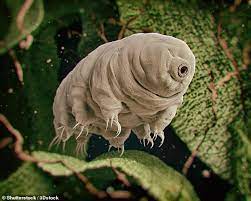Tardigrades, often lovingly referred to as “water bears” or “moss piglets,” are tiny, resilient creatures that have captured the curiosity of scientists and enthusiasts alike. Despite their minuscule size, tardigrades possess an array of remarkable abilities and characteristics that make them stand out in the animal kingdom. In this article, we delve into the incredible world of
tardigrades and unveil 52 captivating facts about these extraordinary microorganisms.

- Incredible Survival Skills: These animals are renowned for their ability to survive extreme conditions, from the vacuum of space to the depths of the ocean.
- Microscopic Marvels: These tiny creatures typically measure between 0.1 and 1.5 millimeters in length, making them invisible to the naked eye.
- Global Distribution: Tardigrades can be found in diverse environments, including rainforests, deserts, and even Antarctica.
- Ancient Existence: Tardigrades have been around for over 500 million years, outdating many other species on Earth.
- Cryptobiosis Masters: Tardigrades can enter a state called cryptobiosis, where they lose almost all their body water and essentially “shut down” to endure harsh conditions.
- Surviving Radiation: This animal can withstand ionizing radiation levels hundreds of times higher than what would be lethal for most animals.
- Extreme Temperatures: They endure temperatures ranging from absolute zero to well above the boiling point of water.
- Dehydration Tolerance: Tardigrades can lose up to 99% of their water content and still recover when rehydrated.
- Hitchhikers in Space: Tardigrades have survived space travel on the exterior of spacecraft.
- Adaptive Anatomy: They have unique features like four pairs of legs with claws, providing exceptional mobility.
- Intriguing Diet: These animals are macrophages, that feed on plant cells, bacteria, and other microorganisms.
- Slow Movers: Despite their resilience, these animals are not known for their speed, typically moving at a leisurely pace.
- Named by Spallanzani: The term “tardigrade” was coined by Italian biologist Lazzaro Spallanzani in the late 18th century.
- Water Dependence: This animal primarily lives in aquatic environments, including mosses, lichens, and soil.
- Stout Bodies: They have a cylindrical body shape, with a protective cuticle covering their segments.
- Sexual Reproduction: Tardigrades reproduce sexually, with males and females coming together for mating.
- Parthenogenesis: Some tardigrade species can reproduce without mating, through a process called parthenogenesis.
- Egg Laying: Females lay eggs, which can withstand harsh conditions until they hatch.
- Hibernation-Like State: This animal can enter a state resembling hibernation when conditions are unfavorable.
- Exoskeleton: Their exoskeleton provides protection and helps maintain their shape.
- Resilient DNA: This animals have unique DNA repair mechanisms, aiding in their survival.
- Variety of Species: Over 1,300 tardigrade species have been identified worldwide.
- Cute Nicknames: Tardigrades’ charming appearance has led to affectionate nicknames like “water bears” and “moss piglets.”
- Fossils Found: Fossilized this animal have been discovered in amber, dating back millions of years.
- Scientific Research: Tardigrades are subjects of extensive scientific research due to their resilience and potential applications.
- Aquatic Ecosystems: They play a vital role in the ecology of aquatic environments, where they help regulate microorganism populations.
- Nocturnal Creatures: These animals are often more active at night, avoiding harsh sunlight.
- Resistant to Chemicals: They can tolerate exposure to various chemicals, further highlighting their resilience.
- Hydrostatic Skeleton: This animal relies on fluid-filled body cavities for support and movement.
- Complex Gut System: Their digestive system consists of a pharynx, esophagus, and intestine.
- First Discovered in 1773: This animal was first described by German pastor and zoologist Johann August Ephraim Goeze.
- Unique Reproduction: Tardigrades have a distinct method of sperm transfer involving a needle-like structure.
- Symbiotic Relationships: Some of these animals have symbiotic relationships with other microorganisms.
- Tiny Brain Ganglia: They possess a small brain-like structure called ganglia, connected to nerve cords.
- Diverse Habitats: Tardigrades can be found in soil, leaf litter, and even on rooftops.
- Species Isolation: Their isolated habitats have led to speciation, creating diverse tardigrade species.
- Artificial Induction of Cryptobiosis: Researchers have successfully induced cryptobiosis in this animal in lab experiments.
- Pioneers in Space Research: This animal was among the first organisms sent into space to study their resilience.
- Bioengineering Potential: Scientists explore the potential of tardigrade genes for bioengineering applications.
- Education and Outreach: These animals are often used in educational programs to inspire curiosity about biology.
- Secretive Moulting: This animal sheds their exoskeleton through a secretive process called ecdysis.
- Tardigrades in Pop Culture: These resilient creatures have made appearances in literature, art, and even video games.
- Understudied Biodiversity: Despite their ubiquity, this animal remains an understudied component of biodiversity.
- Tardigrades in Extreme Films: They have inspired the creation of fictional creatures in sci-fi and fantasy films.
- Medical Interest: Tardigrades’ unique DNA repair abilities hold potential relevance in medical research.
- Resilience Mystery: The exact mechanisms behind this animal’s incredible resilience are still a subject of ongoing research.
- Tardigrades and Climate Change: Understanding how these animals respond to climate change is a critical research area.
- Space Colonization Discussions: This animal’s ability to survive in space has sparked discussions about potential space colonization.
- Microscopic Expeditions: Tardigrade enthusiasts often embark on microscopic expeditions to find these creatures in the wild.
- Endearing Microfauna: This animal’s unique characteristics and charming appearance make them endearing subjects of study.
- Tardigrade Conservation: Efforts to protect their habitats are crucial to preserving tardigrade diversity.
- Inspiring Resilience: This animal serves as a reminder of the incredible resilience and adaptability of life on Earth.



















Add Comment